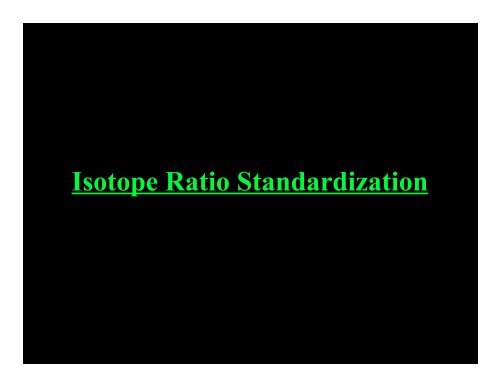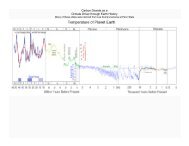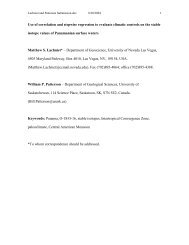Standardization lecture
Standardization lecture
Standardization lecture
You also want an ePaper? Increase the reach of your titles
YUMPU automatically turns print PDFs into web optimized ePapers that Google loves.
Isotope Ratio <strong>Standardization</strong>
• we’ve seen in class that waters are standardized against<br />
SMOW (or VSMOW), carbonates against PDB (or VPDB),<br />
nitrogen against AIR, etc.. But what does this mean?
• we’ve seen in class that waters are standardized against<br />
SMOW (or VSMOW), carbonates against PDB (or VPDB),<br />
nitrogen against AIR, etc.. But what does this mean?<br />
• each scale has its own arbitrary zero point. For waters<br />
this is VSMOW. The definition of the delta value (in<br />
terms of oxygen):<br />
δ 18 O sample-VSMOW = ( ( 18 O/ 16 O) sample / ( 18 O/ 16 O) VSMOW – 1 ) * 1000‰
• we’ve seen in class that waters are standardized against<br />
SMOW (or VSMOW), carbonates against PDB (or VPDB),<br />
nitrogen against AIR, etc.. But what does this mean?<br />
• each scale has its own arbitrary zero point. For waters<br />
this is VSMOW. The definition of the delta value (in<br />
terms of oxygen):<br />
δ 18 O sample-VSMOW = ( ( 18 O/ 16 O) sample / ( 18 O/ 16 O) VSMOW – 1 ) * 1000‰<br />
• If we plug VSMOW into this formula, we calculate a<br />
value of zero. Hence this is the material that the<br />
oxygen value of waters (plus other compounds) are<br />
anchored to.
• we generally use a two point calibration that spans the<br />
range of isotope values we analyze. In this way we<br />
eliminate error that can occur from a one point<br />
calibration, and we ensure inter-laboratory consistency<br />
of analyses. We will see how this works in detail in<br />
Tutorial 8 when we reduce the data for your hair<br />
samples.
• we generally use a two point calibration that spans the<br />
range of isotope values we analyze. In this way we<br />
eliminate error that can occur from a one point<br />
calibration, and we ensure inter-laboratory consistency<br />
of analyses. We will see how this works in detail in<br />
Tutorial 8 when we reduce the data for your hair<br />
samples.<br />
• what is the difference between SMOW and VSMOW, or<br />
PDB and VPDB? The IAEA controls the dissemination of<br />
stable isotopic standard material to the world. The<br />
original water O and H scales were anchored to SMOW<br />
and the carbonate C and O scales were anchored to<br />
PDB. SMOW (Standard Mean Ocean Water) was an<br />
actual batch of water samples that had δ 18 O = δD = 0‰,<br />
by definition (no error). Likewise for PDB (Peedee<br />
Belemnite, the rostrum of a squid-like animal that was<br />
found in the Peedee Formation) δ 18 O = δ 13 C = 0‰
• but these original batches were exhausted over time,<br />
and new batches had to be synthesized. Unfortunately<br />
it is very difficult to make a new batch of water, or find<br />
a carbonate sample, that has the exact same isotope<br />
ratios as SMOW, or PDB, respectively.
• but these original batches were exhausted over time,<br />
and new batches had to be synthesized. Unfortunately<br />
it is very difficult to make a new batch of water, or find<br />
a carbonate sample, that has the exact same isotope<br />
ratios as SMOW, or PDB, respectively.<br />
• IAEA synthesized a water sample that has isotope ratios<br />
very close to SMOW. They also found a homogeneous<br />
carbonate sample from the Toilet Seat Formation (TSL-<br />
ST or NBS-19). Rather than associate an error with<br />
these standards, the international community decided<br />
to set the new water standard as δ 18 O = δD = 0‰.<br />
Likewise the new carbonate standard NBS-19 was set to<br />
δ 13 C = 1.95‰ and δ 18 O = -2.20‰. But this is not exactly true<br />
as these new materials are slightly different. So we<br />
now use VSMOW to refer to the new water scale and<br />
VPDB to refer to the new carbonate scale. This way we<br />
can track what particular standards samples were<br />
calibrated against.
Uncertainty In Isotope Ratio<br />
Measurements
• mass spectrometers are used to measure isotope ratios.<br />
But a mass spectrometer is a precision machine, not an<br />
accuracy machine. We must standardize in order to<br />
achieve accuracy.
• mass spectrometers are used to measure isotope ratios.<br />
But a mass spectrometer is a precision machine, not an<br />
accuracy machine. We must standardize in order to<br />
achieve accuracy.
• when we make our measurements we have two sources<br />
of uncertainty to keep track of: measurement<br />
uncertainty and uncertainty in standards used in<br />
calibrations.
• when we make our measurements we have two sources<br />
of uncertainty to keep track of: measurement<br />
uncertainty and uncertainty in standards used in<br />
calibrations.<br />
• measurement uncertainty can arise from many sources:<br />
-fluctuating conditions in the mass spectrometer<br />
(and the peripheral devices that prepare our<br />
samples) during the analyses. Ambient factors<br />
such as temperature and humidity play a role, and<br />
internal factors such as stability of electronics are<br />
important.<br />
-measuring very small ion beams such as the HD<br />
beam in hydrogen isotope measurements, or very<br />
small samples in general.<br />
-how well tuned the mass spectrometer is.<br />
-how clean the ion source is.<br />
-etc.
• these factors all contribute to a scatter that occurs in<br />
data, which we refer to as reproducibility or precision.<br />
We make a measurement of this scatter for our<br />
standards and report it with all data, to give the clients<br />
a feel for how good our measurements are.
• standards from the IAEA may come as two types: those<br />
that are set to exact values, so do not have any error<br />
associated with them (e.g. VSMOW, VPDB), and others<br />
that have an uncertainty associated with them. These<br />
latter will introduce additional uncertainty into our<br />
measurements.
• standards from the IAEA may come as two types: those<br />
that are set to exact values, so do not have any error<br />
associated with them (e.g. VSMOW, VPDB), and others<br />
that have an uncertainty associated with them. These<br />
latter will introduce additional uncertainty into our<br />
measurements.<br />
• in the case of nitrogen there exist no standards from<br />
the IAEA that are set to any values by definition. The<br />
nitrogen data in our lab is calibrated against two IAEA<br />
standards: USGS25 (ammonium sulphate) δ 15 N = -30.4‰<br />
± 0.4‰ AIR, and IAEA-305A (also ammonium sulphate)<br />
δ 15 N = 39.8‰ ± 0.25‰ AIR. We must keep these<br />
uncertainties in mind when we report the overall<br />
uncertainty for our samples. The total uncertainty is a<br />
combination of machine uncertainty (precision) and<br />
standard uncertainty (accuracy).
• there are other factors that can contribute to the quality<br />
of isotopic measurements. One extremely important<br />
one is homogeneity. This has two facets to it: (1) is<br />
your sample really a true representation of what you<br />
want to measure; and (2) is your sample well mixed so<br />
that if I take a small portion of it to measure it will<br />
agree with other analyses from that same batch of<br />
sample. Our overall precision can quickly be destroyed<br />
from a poorly homogenized sample, and the accuracy<br />
we may think we’ve obtained may be incorrect due to a<br />
poorly chosen sample (i.e. the sample does not reflect<br />
its source).
• hence all of the delta values that we have been<br />
supplying for you in the labs have a certain amount of<br />
uncertainty associated with them. A good lab will have<br />
a solid QC/QA (quality control/quality assurance)<br />
program in place to assure high data quality. For<br />
example, when we run carbonate samples in our lab we<br />
run the international standard NBS-19 directly to<br />
calibrate all data. We also run an in-house standard as<br />
a check on the calibration. We report the results of this<br />
in-house standard to our clients as well as the accepted<br />
value of this standard so they can see the quality of the<br />
run for themselves. Also, and most importantly, we run<br />
repeats of samples at random. This is the ultimate<br />
check on how good the analysis is. Note that<br />
homogeneity is crucial, and it is up to the client to send<br />
homogeneous samples, otherwise we cannot guarantee<br />
the quality of the analysis.
• Note: many isotope laboratories cheat when it comes to<br />
reporting uncertainties, and they tend to report the<br />
precision of the measurement as the overall<br />
uncertainty. Not only that, but the precision they report<br />
is based on many runs of a homogeneous standard. A<br />
sample is not run many times to a statistically better<br />
result for its isotope value, but run only once. So how<br />
relevant is the precision of your standard you ran 20<br />
times to a single sample analysis?
• Note: many isotope laboratories cheat when it comes to<br />
reporting uncertainties, and they tend to report the<br />
precision of the measurement as the overall<br />
uncertainty. Not only that, but the precision they report<br />
is based on many runs of a homogeneous standard. A<br />
sample is not run many times to a statistically better<br />
result for its isotope value, but run only once. So how<br />
relevant is the precision of your standard you ran 20<br />
times to a single sample analysis?<br />
• in general the Saskatchewan Isotope Laboratory reports<br />
the following uncertainties:<br />
-C and O from carbonates: ±0.05‰ and ±0.10‰ VPDB,<br />
respectively.<br />
-D and O from waters: ±2‰ and ±0.2‰ VSMOW, respectively.<br />
-C and N from organics: ±0.1‰ and ±0.4‰ VPDB and AIR,<br />
respectively.
Sample Calculation
• how exactly does the software go about calculating a<br />
delta value from measurements? Here is an example of<br />
calculating δ 13 C for CO 2 generated from CaCO 3 :
• Given Info from Analysis (which we all should somewhat<br />
understand from the lab tours):<br />
Sample CO 2 Ion Beam Intensity (mV)<br />
mass 44 mass 45 mass 46<br />
4727.247 5646.864 6090.994<br />
Ref CO 2 Ion Beam Intensity (mV)<br />
mass 44 mass 45 mass 46<br />
4703.024 5538.986 6054.629<br />
Background CO 2 Ion Beam Intensity (mV)<br />
mass 44 mass 45 mass 46<br />
2.71 3.27 3.62<br />
Ref Gas<br />
δ 13 C -13.26‰, VPDB<br />
δ 18 O -10.80‰, VPDB
Step 1<br />
Subtract backgrounds from signal (done automatically by software).
Step 1<br />
Subtract backgrounds from signal (done automatically by software).<br />
Step 2<br />
Calculate ratios:<br />
Sample<br />
45CO2 / 44CO2 46CO2 / 44CO2 1.194535424 1.288486512<br />
Ref<br />
45CO2 / 44CO2 46CO2 / 44CO2 1.17774989 1.287390624
Step 3<br />
Calculate CO 2 delta values of sample wrt reference:<br />
δ 45 CO 2 sample-ref = ((( 45 CO 2 / 44 CO 2 ) sample /( 45 CO 2 / 44 CO 2 ) ref ) - 1) * 1000‰<br />
δ 46 CO 2 sample-ref = ((( 46 CO 2 / 44 CO 2 ) sample /( 46 CO 2 / 44 CO 2 ) ref ) - 1) * 1000‰<br />
δ 45 CO 2 sample-ref = 14.25‰<br />
δ 46 CO 2 sample-ref = 0.85‰
Step 4<br />
Apply Boato equation to calculate delta values of the sample wrt<br />
VPDB:<br />
δ 45 CO 2 sample-VPDB = δ 45 CO 2 sample-ref + δ 45 CO 2 ref-VPDB + (δ 45 CO 2 sample-ref * δ 45 CO 2 ref-VPDB<br />
/1000)<br />
δ 46 CO 2 sample-VPDB = δ 46 CO 2 sample-ref + δ 46 CO 2 ref-VPDB + (δ 46 CO 2 sample-ref * δ 46 CO 2 ref-<br />
VPDB/1000)<br />
δ 45 CO 2 sample-VPDB = 1.31‰<br />
δ 46 CO 2 sample-VPCB = -9.98‰
Step 5<br />
Craig 17 O Correction<br />
δ 13 C = (1.0676* δ 45 CO 2 ) - (0.0338 * δ 18 O)<br />
δ 18 O = (1.0010 * δ 46 CO 2 ) - (0.0021 * δ 13 C)<br />
δ 13 C sample-VPDB = 1.73‰
Step 5<br />
Craig 17 O Correction<br />
δ 13 C = (1.0676* δ 45 CO 2 ) - (0.0338 * δ 18 O)<br />
δ 18 O = (1.0010 * δ 46 CO 2 ) - (0.0021 * δ 13 C)<br />
δ 13 C sample-VPDB = 1.73‰<br />
• Note: a two-point calibration negates all of this, and<br />
makes data reduction much simpler to handle. But the<br />
only way to do a two-point calibration is by having two<br />
end-member standards that you know the delta values<br />
of, and the above calculations are involved in<br />
determining those values. So it is not really that these<br />
calculations are negated, just hidden.
But why cheat ourselves out<br />
of all of this fun???
Get lost.
Get lost.<br />
Have a good break.







